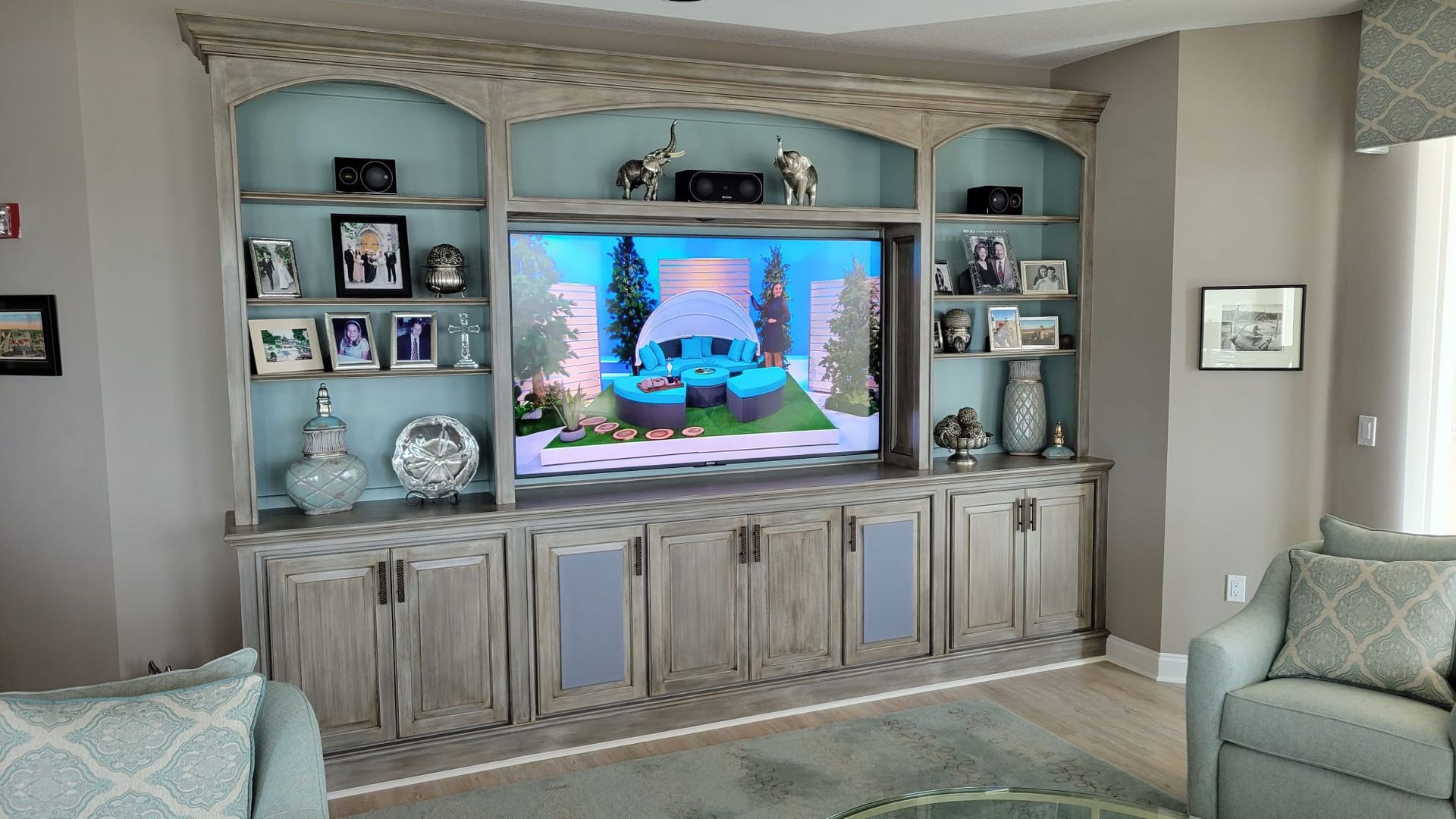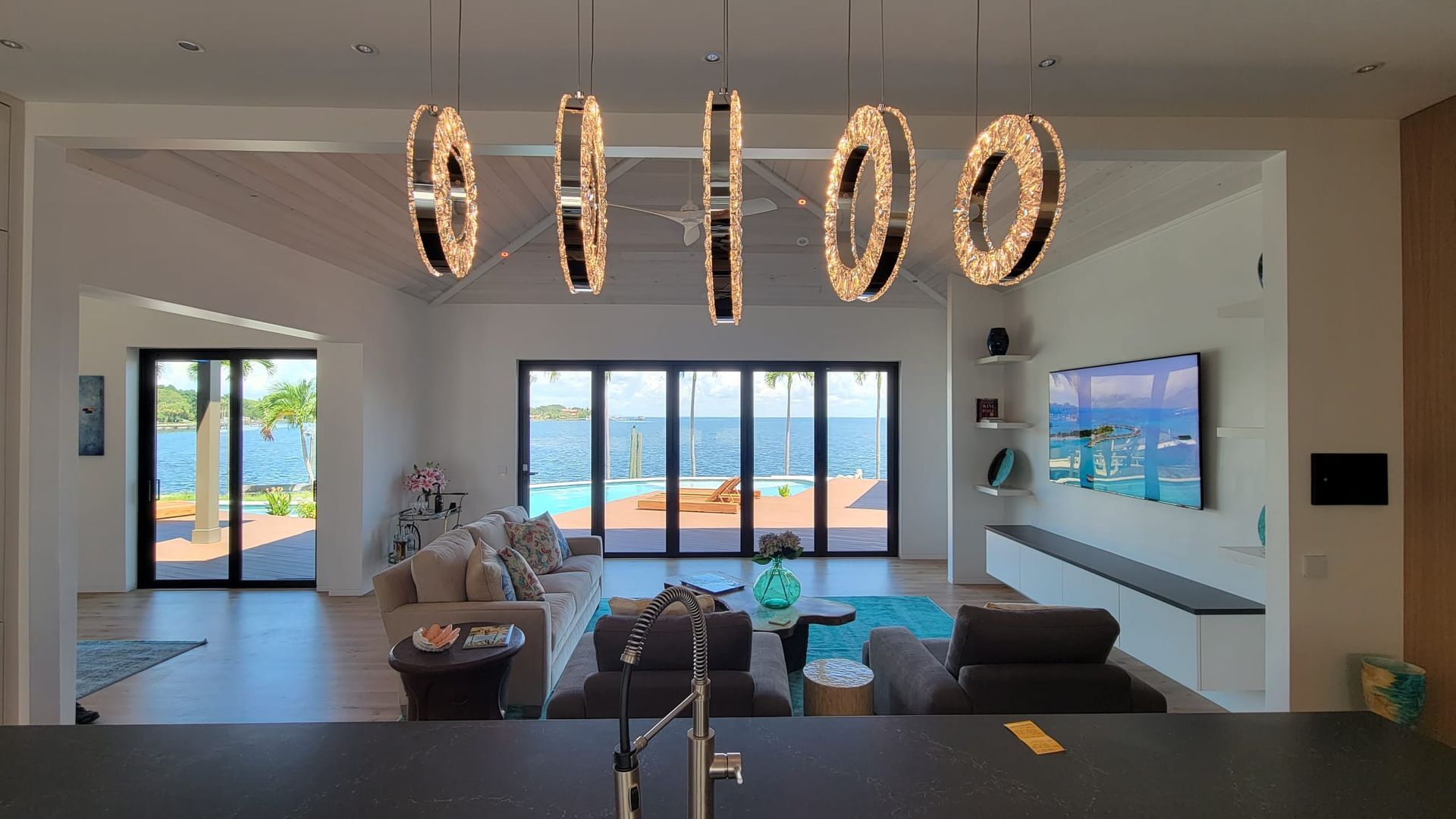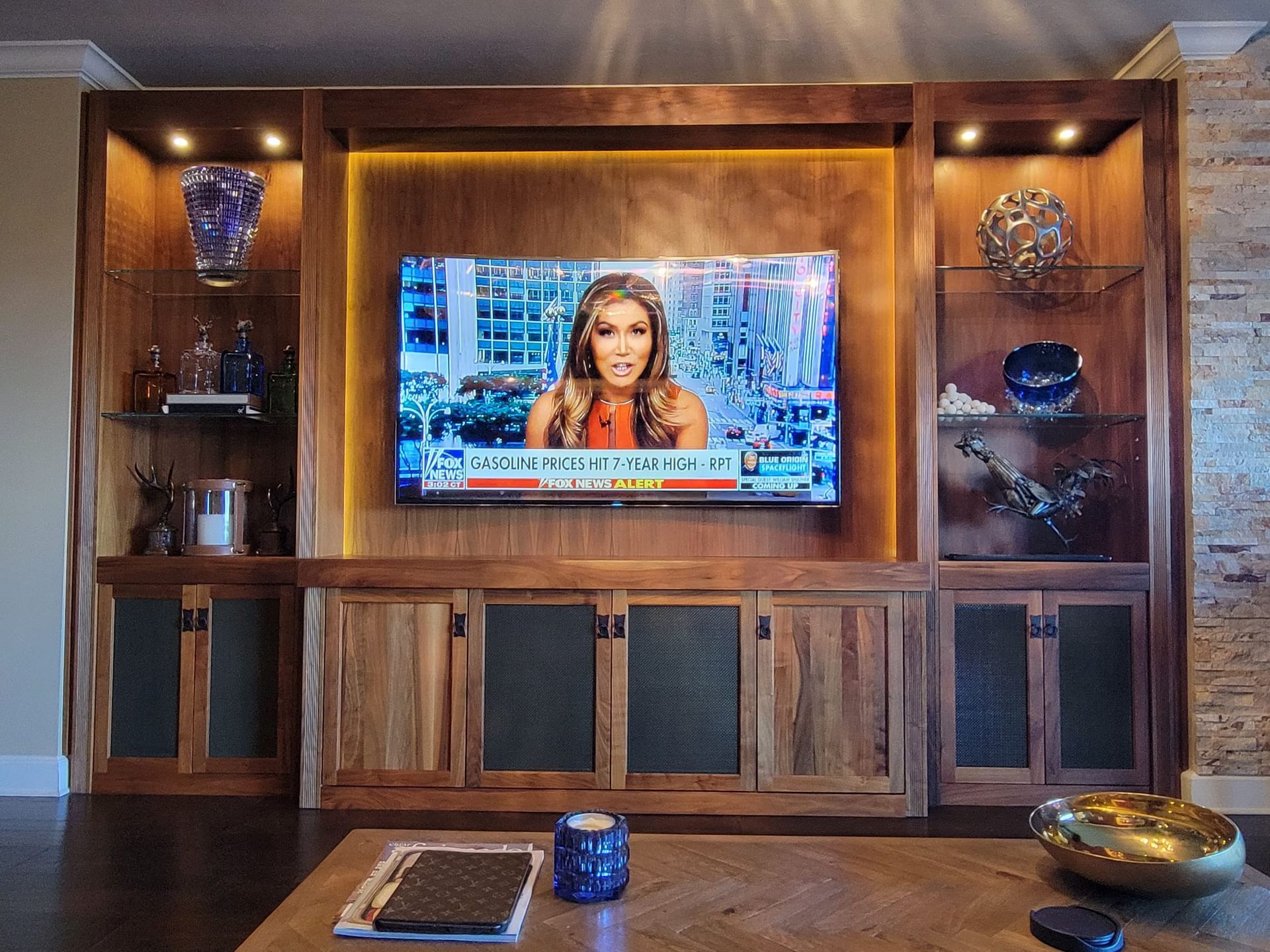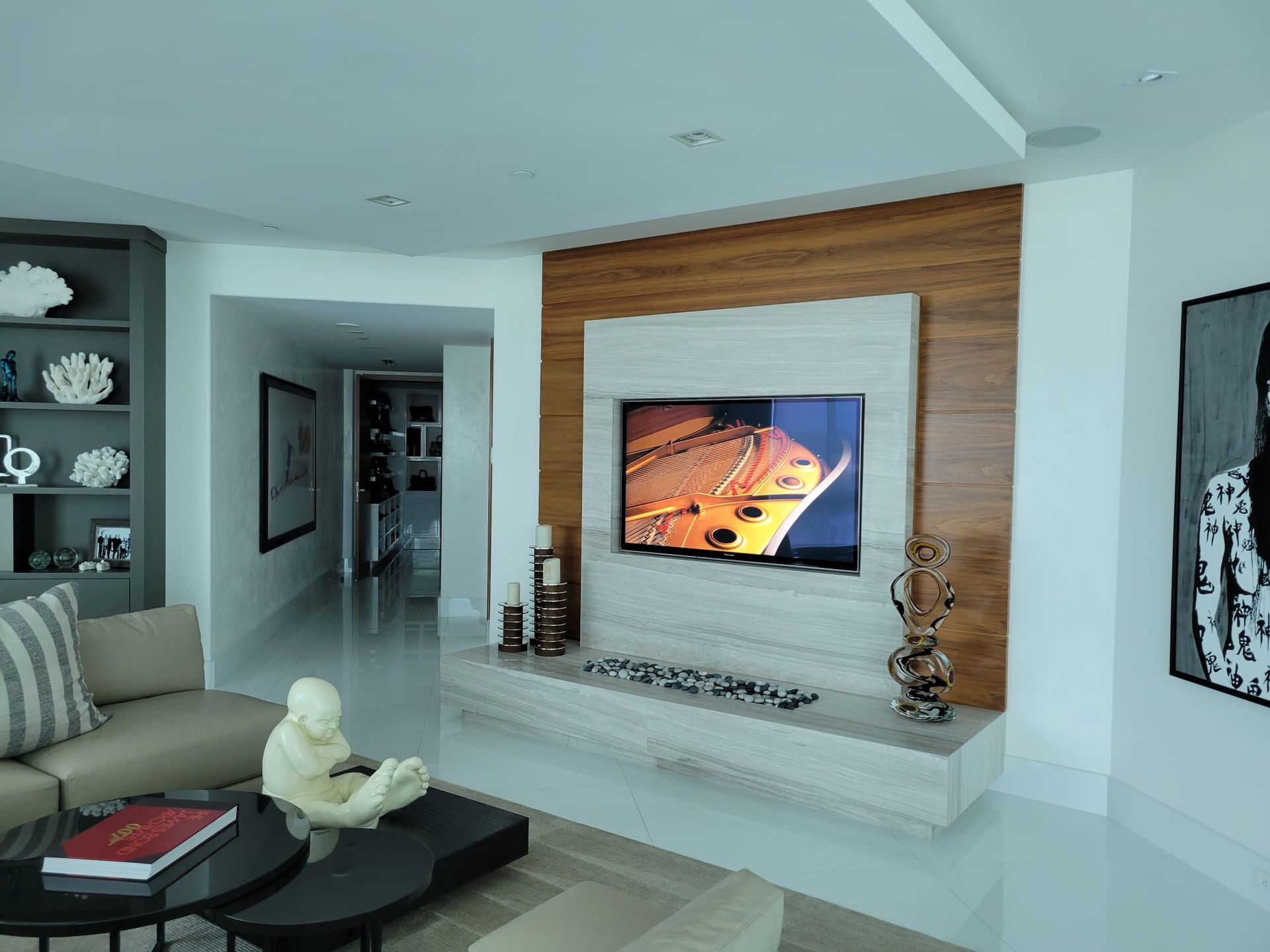Living Room Surround Sound Systems
Your Home. Our Expertise. Perfect Sound.
Entertainment Pros proudly services all of Pinellas, and areas of Hillsborough and Pasco.
Surround Sound Systems
A high-quality surround sound system can create an immersive experience for movies, music, gaming, or just watching TV at the end of the day. Whether you're hosting a movie night, enjoying your favorite playlist, or playing the latest video game, the right sound system can bring you enjoyment every time you turn it on. A great audio setup ensures that every sound is crisp, clear, and perfectly balanced, making your living room the ideal space for entertainment. Pair a great surround sound system with a great TV and you have an immersive experience that you can enjoy every day, for years.
In this guide, we’ll explore your options for living room surround sound systems and installation. From traditional surround sound setups to modern wireless and WiFi speakers, there’s something for every preference and budget.
Bookshelf Configuration
Monitor Audio 'Radius' bookshelf speakers positioned in the wall unit. Front firing SpeakerCraft 10 inch subwoofer below in vented custom cabinet. Equipment located in bottom cabinet.
Discrete Aesthetics
Stealth Acoustics invisible in wall L/C/R front speakers. In-celling Monitor Audio 'Controlled Performance' surround speakers. Dual down firing SpeakerCraft 10 inch subwoofers mounted in floating custom cabinet. Equipment rack located in adjacent laundry room.
Concealed Configuration
Monitor Audio 'Silver' series bookshelf speakers and SpeakerCraft 12 inch subwoofer concealed in a vented custom cabinet. Equipment located in bottom cabinet.
Ceiling Configuration
Monitor Audio 'Controlled Performance' in-ceiling L/C/R fronts, surrounds, and surround back with SpeakerCraft 12 inch subwoofer in rear corner. Equipment located in room behind the TV.
Choosing the Best Surround Sound System for Your Living Room
A surround sound system can significantly enhance your living room entertainment experience by providing immersive audio that envelops you from all directions. These systems typically include multiple speakers positioned around the room, delivering clear and dynamic sound that makes you feel like you're part of the action. The benefits of having a surround sound system in your living room include:
Enhanced Audio Quality
High-definition sound for movies, music, and games. Clear treble promises high frequencies for intelligibility and rich, full bass completes the experience.
Immersive Experience
Feel fully immersed in your entertainment with sound coming from all angles. Correctly configured speakers place you "IN" the soundstage so you feel like part of the performance!
Increased Value & Enjoyment
Add value to your home with a high-quality audio system. Most importantly, enjoy the the place where you spend most of your time.
Living Room Surround Sound
Top Recommendations
Choosing the right surround sound system for your living room depends on your budget, room size, and personal preferences. Here are some top-rated options to consider.
Three low-profile Monitor Audio speakers under the TV, surround speakers in the ceiling, and a SpeakerCraft subwoofer hides in the corner.
Tell Us about your Next Project
We will get back to you as soon as possible.
Please try again later.
Budget-Friendly Options
- A soundbar/subwoofer combo, sometimes the same brand as your TV manufacturer, will offer better sound than just your small, tinny TV speakers.
- Sonos soundbar/subwoofer, possibly with Sonos surround speakers, deliver far better sound and more clarity and bass than most inexpensive soundbar/subwoofer options.
- Both of these options can sometimes be utilized with your existing remote controls to keep the costs down but at the cost of convenience- you may end up doing the "remote control shuffle".
Mid-Range Choices
- A lower-priced Yamaha surround sound receiver with smaller bookshelf speakers, a basic quality subwoofer and properly programmed remote control are a gigantic step up from the lower-priced options in both enjoyment and ease of use.
High-End Systems
- A good Yamaha Aventage surround sound receiver will have much better audio quality (higher-end products don't just bring more power, they provide better "Everything").
- Dual smaller subwoofers provide better bass at a balanced level throughout your room without it being too boomy in one area and not enough in other areas.
- Monitor Audio speakers with at least 5"-6" main drivers and C-Cam tweeters can provide a tremendous improvement in audio quality and the sound you didn't realize you were missing.
- URC computer-programmed remote control with a matching RF module or Elan/Nice control system will allow seamless control and stressless operation that is well worth the cost, even if your gear is behind doors.
When selecting a system, consider factors like room size, how much time you spend there, availability to run wires, and how important sound quality is to you.
Project Spot Light Upgrading a Bonus Room into a Home Theater
At "Sound Advice" when I began my journey in audio/video and home theater design and installation, I converted many upstairs "bonus rooms" or "media rooms" into dedicated home theaters. These rooms generally had sloping sides formed by the roofline and were isolated from the bedrooms or main use areas, making them perfect for a remote theater room. Over the years I have seen fewer of these floor plans, but whenever I come across them it reminds me of past projects.
Installation and Choosing a Local Installer
Opting for professional installation ensures your sound system is set up correctly, looks professional and performs at its best. We regularly come across new clients with systems which were never adjusted properly for optimum bass/treble or levels, are too frustrating to control, or have exposed wires.
Optimal Equipment Selection
What do you watch? How do you stream? Do you entertain? We will guide you in selecting the proper equipment for your budget, scale and needs.
System Compatibility
We ask our clients what their needs are. Some components are geared specifically to perform better with other matching products. We insure that every piece works with the others for a cohesive system.
Professional Installation
We frequently come across clients with systems designed and installed by other companies that never took the time to address the fundamentals. Adjusting bass and treble, balancing speaker levels, labeling wires and basic wire management make a tremendous difference in the sound and appearance of your home.
Post-Installation Support
If you have a question or concern after the installation, call us! Also, if you have a system someone else installed that is embarrassing to look at, doesn't seem to perform as you expected, or is difficult to control- call us, we can get you where you want to be.
How to Choose an Installer
Selecting the right installer is crucial for a hassle-free setup and excellent performance. Here’s how to find the best local installer:
Research and Reviews
Look for installers with positive customer reviews and high ratings. Check out our 5-star rating for living room surround sound installer, Google-verified reviews here.
Experience and Expertise
Choose an installer with extensive experience in home audio systems. We have over 25 years of experience designing and installing surround sound systems in living rooms.
Consultations
Schedule consultations to discuss your needs and assess their approach. Click here and tell us about your project to set up an estimate.
References
Ask for references or examples of past installations to gauge their quality of work. We would be happy to put you in touch with our past clients.
Schedule with Entertainment Pros
Ready to transform your living room with the perfect sound system? Schedule a professional installation with Entertainment Pros today. Our team of experts is dedicated to ensuring your system is installed correctly and performs at its best. Contact us to set up a consultation and take the first step toward an unparalleled audio experience.
Contact Us
We will get back to you as soon as possible.
Please try again later.
Setting Up Surround Sound in Your Living Room
Proper planning is essential for achieving the best sound quality from your surround sound system. Here are some key tips:
Speaker Placement
Position front and center speakers at ear level when seated. Place front speakers on either side of the TV, try for 45 degrees apart from your seating position to the speakers. Keep the center speaker above or below the TV, and surround speakers behind your seating and in line with the front speakers to keep you in the middle of the sound.
Room Acoustics
Furniture Placement
Arrange furniture to avoid obstructing speaker paths. If you can't see your speakers where you are seated, you aren't getting the best sound to your ears. Ensure that the primary seating area is in the “sweet spot” where sound converges for the best listening experience.
Living Room Surround Sound Installation
Setting up your surround sound system can be straightforward with the right approach.
Unbox and Inspect
Ensure all components are present and undamaged.
Position Speakers
Front Speakers: Place on either side of the TV at ear level.
Center Speaker: Place above or below the TV.
Rear Speakers: Position behind and to the sides of the seating area.
Subwoofer: Place near the front speakers but can be moved to find the best bass response. Corner locations are the most effective.
Connect Components
Use the correct wires and cables to connect the speakers, sources, and display to your receiver, ensuring secure connections.
Calibrate System
Utilize the receiver’s calibration microphone to adjust the audio settings for basic speaker level and equalization. This only provides a starting point, from there we will listen and add more precise adjustments to get the best out of your equipment.
Test Sound
We play various audio types to ensure balanced and clear sound along with correct bass levels, making adjustments as needed. More current music has increased bass, the oldies don't exhibit much bass, the music you listen to and your preferences will dictate what you need.
Sound Quality Tips
Begin with the receiver's optimizer microphone for a starting point in setting your audio parameters
Insure the speakers, no matter how large, are all set to "small" in the receiver settings. This will send the bass to the subwoofer, and the mid/high frequencies to the speakers. All speaker/subwoofer crossover points should be set at 80Hz for speakers with 5"-6" main drivers. Speakers with smaller drivers will need the crossover points to be set higher or you can risk damaging your speakers with too much bass. Consult your speaker specs for guidance.
Adjust all speaker levels from your seating location to get the most out of your system.
Set the subwoofer crossover point to 80Hz when paired with front speakers having 5"-6" or larger main drivers. You will need to set the crossover a little higher (maybe 100Hz or 120Hz if your main speakers have smaller drivers (like 4" or smaller).Try to locate your subwoofer in an accessible location so you can increase or decrease the bass level as needed, different sources and types of music/movies can cause bass levels to vary greatly, resulting in needed level adjustments on occasion. Also, placing subwoofers in corners increases the bass in the room, so you get more bass while turning it up (and disturbing other rooms ) less.
Wireless Sound Systems for Your Living Room
Wireless sound systems offer unmatched convenience and flexibility, making them a popular choice for many homes. Here are some of the key advantages:
Ease of Setup
Without the need for extensive wiring, wireless systems simplify the installation process, reducing clutter and saving time.
Flexibility
Easily reposition bookshelf speakers to suit your space and preferences, and expand your system as needed. While "wireless" speakers do not rely on interconnecting wiring from the main equipment, they still rely on electrical outlet connections to power the internal amps- so they are only "partially" wireless.
Improved Sound
Achieve greatly improved sound over your TV speakers with less mess and cost
Comparison: Bluetooth vs. WiFi Systems
- Bluetooth Systems: Ideal for short-range connections, Bluetooth systems are great for connecting devices like smartphones and tablets. They offer ease of use but can be limited by range and potential interference. They also can rely on audio compression which can degrade sound quality
- Wi-Fi Systems: Wi-Fi systems provide a stronger, more stable connection over longer distances, making them suitable for whole-home setups. They support higher audio quality and multiple device connections simultaneously.
| System Type | Advantages | Disadvantages |
|---|---|---|
| Bluetooth Systems | Ideal for short-range connections, great for smartphones/tablets, ease of use | Limited range, potential interference |
| Wi-Fi Systems | Stronger, stable connection over longer distances, suitable for whole-home audio, higher audio quality, supports multiple device connections | Requires a strong Wi-Fi network, potential setup complexity |
Enhance Your Home Entertainment Experience
Wireless Sound Systems for Living Rooms
Sonos Soundbar, Subwoofer and Speakers
Pros: Superior sound quality, easy integration with other Sonos products, voice control. Sonos products presently own the market for the wireless sound category
Cons: Higher price point, requires a strong Wi-Fi connection for best performance. Wireless systems transmit the audio signal wirelessly, but will require an electrical outlet to power each speaker unit.
Soundbar Considerations
Along with the previously mentioned Pros and Cons with a Sonos or similar soundbar/speaker/subwoofer system, there is something else to consider- soundbar speaker separation. For the best surround sound reproduction and the truly immersive sound that we aim for, the front speakers should be around 45 degrees apart , as located from the optimum seating location.
For a common 12' seating distance, the 45 degree optimum speaker separation results in a recommended speaker separation between the left and right speakers of around 9-10 feet. Most soundbars are going to place the speakers around 4'-5' apart, which is about half of the suggested distance.
This results in a far less immersive experience. In relative terms, you are not surrounded by the speakers with them being around (outside of ) you, they are in front of you. The car, jet, bullets, or orchestra aren't all around your location, so they can't "move" from LEFT of you to IN FRONT of you then to the RIGHT you, they are just moving across in front of you, at a greatly reduced distance (angle). This is a large portion of the realism that can be achieved with a great system that has the speakers placed in the optimum position as opposed to the width of a soundbar that is a similar width to your TV.
5.1 Surround Sound
5.1 Living Room Sound System Setups
A 5.1 surround sound system consists of six channels: five full-bandwidth channels and one low-frequency effects channel (the ".1"). The five channels include:
Front Speakers
Placed on either side of the TV, around 10'-12' (approx. 45 degrees apart, from your seating position) apart for a truly immersive audio experience. Obviously, this has to coincide with your room/furniture/cabinet layout, and we do the best we can, but it needs to work with your room. If you can't get that 45 degree separation, get the closest you can.
Center Speaker
Positioned above or below the TV to enhance dialogue clarity. The center speaker should match your left/right front speakers for tonal matching and a seamless transition of sound.
Rear Speakers
Strategically placed behind and to the sides for surround sound effect.
Subwoofer
Delivers deep bass for a cinematic audio experience. Two smaller subwoofers will deliver more even, balanced bass throughout your room than one larger subwoofer.
5.2 Surround Sound
5.2 Living Room Sound System Setups
A 5.2 surround sound system includes all the components of a 5.1 setup with an additional subwoofer. This provides two low-frequency effects channels.
Improved Room Coverage
Multiple subwoofers can fill in bass gaps caused by room acoustics, ensuring a richer and fuller bass experience.
Enhanced Bass Distribution
Two subwoofers offer more even bass distribution throughout the room. Bass tends to collect in corners, so the corner with the subwoofer as well as the opposing corner in the room will likely have increased bass. The other corners and areas in the room will have decreased bass.
Reduced Distortion
With two subwoofers, each can operate at a lower volume, reducing distortion and improving sound clarity.
Greater Dynamic Range
Dual subwoofers can handle a wider range of frequencies and dynamic changes in audio, delivering a more impactful and nuanced bass performance, along with the more evenly distributed bass throughout the room.
Front firing speakers vs ceiling mounted
Speakers | Living Room Sound System Setups
When setting up your home audio system, choosing between front-firing speakers and ceiling-mounted speakers is an important decision that can significantly impact your listening experience. Both types of speakers have their unique advantages and are suited to different room layouts and audio needs. Below, we'll explore the key differences between these two options to help you decide which setup is best for your living room.
Front-Firing Speakers
Front-firing speakers are designed to project sound directly towards the listener. They are typically placed at ear level and are a popular choice for home theaters and living rooms where immersive, directional sound is desired.
Advantages:
- Direct Sound: Provides clear, direct audio aimed at the listening area.
- Enhanced Dialogue Clarity: Ideal for ensuring that speech and other important audio cues are easily understood.
- Flexible Placement: Can be easily repositioned to suit different seating arrangements.
Considerations:
- Space Requirements: Requires floor or shelf space, which may be a limitation in smaller rooms.
- Visual Impact: The speakers are visible, which may affect the room's aesthetics.
Ceiling mounted front speakers
Ceiling-mounted speakers are installed in the ceiling and fire downward. Most designed for this will have aimable tweeters, but they only aim around 15 degrees forward, so they are less likely to deliver as accurate sound as speakers aimed directly at you. The grilles also will pass less sound as you increase the off-angle from directly under the speaker. The farther you move from directly undere, the more "closed" the grille is to the sound attempting to pass through. In-ceiling speakers are often a viable option if you are lacking floor space or have a wall that is not conducive to bookshelf or in-wall speakers.
Advantages:
- Space-Saving: Frees up floor and shelf space, making them ideal for smaller rooms or minimalistic designs.
- Discreet Appearance: Blends seamlessly into the ceiling, reducing visual clutter.
Considerations:
- Installation Complexity: Requires professional installation and may be more difficult to adjust once installed.
- Less Immersive: May not provide the same level of audio clarity as front-firing speakers.
Surround Sound for Different Living Room Layouts
Optimizing Sound for Different Living Room Layouts
Optimizing sound in your living room requires careful consideration of the room’s layout and acoustics. Each type of living room—whether it’s an open plan, small space, or multi-purpose area—presents unique challenges and opportunities for achieving the best audio experience. In this section, we’ll explore tailored strategies for enhancing sound quality in various living room configurations, ensuring you enjoy clear, immersive audio no matter the room size or shape.
Open Plan Living Rooms
Challenges and Solutions
Challenges: Open plan living rooms with their larger spaces can cause less intelligible audio due to echos. Basically, sound from speakers hits your ears directly, while reflected audio bounces off of other surfaces and reaches your ears slightly later. This reflected audio combines with the direct audio results in more garbled audio (kind of like two people talking to you at the same time).
Solutions:
- Use directional speakers to focus sound towards the seating area.
- Place additional speakers in strategic locations to cover more space.
- Consider using soft furniture along with soft surfaces (rugs, drapes, etc.) to minimize the "hard" reflective surfaces (floors, walls, ceilings, windows). These soft surface will absorb sound rather than bouncing it off the rooms.
Small Living Rooms
Tips for Optimizing Sound:
- Choose compact, quality speakers that deliver powerful sound without taking up much space.
- Use a subwoofer with adjustable crossover settings to balance the bass. This also allows you to use smaller front/center speakers.
Family Rooms and Multi-purpose Spaces
Adapting Sound Systems:
- Plan your likely room uses to setup the most feasable speaker, subwoofer, and equipment locations which still allow you use of your room without imposing on the room.
- Utilize recessed ceiling speakers to free up space. Keep in mind that ceiling mounted front speakers, even those with aimable tweeters, will not produce the same clarity as speakers facing you directly, due to the tweeter only being able to be aimed around 15 degrees (from straight down) as well as the more "closed" structure of the metal speaker grill the more the sound attempts to exit it at increased angles.
- Consider optinal equipment layouts with electronics in cabinets/furniture, closets, or other "out of the way" locations.
Sound System
Enhance Your Living Room Surround Sound Experience
Choosing the right sound system for your living room is essential for creating an immersive and enjoyable audio experience. Whether you're opting for a traditional surround sound setup or exploring modern wireless options, the key is to find a system that fits your space, needs, and budget.
We encourage you to explore the various options and setups discussed in this guide to find the perfect solution for your living room. For more detailed guides and product recommendations, check out Entertainment PROs portfolio. Transform your home entertainment with expert advice and top-notch products.
Get in Touch
Contact Us
Phone number
Our address
29656 US Hwy 19 N, Suite 431, Clearwater, FL 33761
Contact form
Contact Us
We will get back to you as soon as possible.
Please try again later.
Check out our photo gallery of past living room surround sound
Inspiring Living Room Surround Sound Photo Gallery
-
Immerse Yourself
Explore More -
The Perfect Setup
See Details -
Quality Sound
Learn More -
Stylish Design
View Gallery
We are a residential audio/video, automation, control, and lighting integration company based in Palm Harbor, Fl. We service all of Pinellas county, and areas of West Hillsborough and West Pasco. We are focused on just one thing - customer service.








